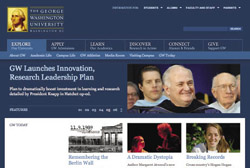First Lady Challenges GW Community to Serve
In return, Mrs. Obama will speak at Commencement

GW senior Shakir Cannon-Moye and Student Association President Julie Bindelglass participated in a Habitat for Humanity community service project with President Barack Obama and Michelle Obama at the Deanwood Housing Project in Northeast Washington, D.C., during the Sept. 11 National Day of Service and Remembrance.
Samantha Appleton
First Lady Michelle Obama has a deal for the GW community: If students, faculty, and staff perform 100,000 hours of community service this academic year, she’ll speak at the University’s Commencement celebration on May 16.
Throughout its history, public service has been one of GW’s core values. Last year alone, GW students logged more than 60,000 hours of service.
“What’s taking place at The George Washington University is what ‘United We Serve’ is all about,” Mrs. Obama says. “My challenge to the GW community is to make service a daily part of their lives.”
Service hours will be collected and tabulated monthly by GW’s Office of Community Service. Volunteerism, service-learning, federal work study service employment, and AmeriCorps service and pro bono service are examples of activities that will go toward meeting the challenge’s goals.
The University’s Student and Academic Support Services has also announced this fall that students and student organizations can apply for part of a $20,000 grant to be allocated for community service and service-learning projects as a way to initiate new ideas and partnerships.
GW launched an online hub at http://serve.gwu.edu to list volunteer opportunities and guidelines, and to highlight service stories throughout the year. The University is also partnering with VolunteerMatch, the popular volunteer network, to track and report the GW community’s service hours on the Web.
Helping Those in Need
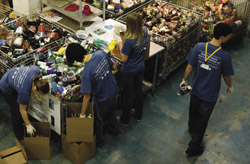
About 1,400 freshmen, more than half the freshman class, served the community on Sept. 11 during GW’s first annual day of service.
William Atkins
They painted hallways, picked up trash, and sorted canned goods. They planted trees, handed out food, and visited veterans. On Sept. 11, about 1,400 GW freshmen visited 12 organizations in the D.C. area to volunteer their time for the first annual Freshman Day of Service. Organized by GW’s Office of Community Service, the event spanned eight wards in the District and sites in Maryland and Virginia, including the Capital Area Food Bank, the Washington Home & Community Hospices, and the Anacostia Watershed Society.
Hours after first lady Michelle Obama challenged the GW community to complete 100,000 hours of service, more than half of the class of 2013 went to work in some of Washington’s neediest areas. The day, which coincided with the first National Day of Service and Remembrance, focused on honoring the country’s military veterans.
During an opening ceremony at University Yard, students in T-shirts with the motto “serving those who serve us” gathered as President Steven Knapp reminded them of their commitment to “foster an engaged, caring community within the larger world community.”
The event’s keynote speaker was Assistant Secretary of the Navy B.J. Penn, MS ’80, who told the students about his experience visiting veterans at the Walter Reed Army Medical Center in Northwest D.C. He emphasized that the day was an opportunity for GW students to thank those who have “offered their lives to protect ours.” “You have the ability to contribute more to this nation than you can imagine,” Mr. Penn told the freshmen. “Imagine what you can do as individuals, as a class.”
Brian Hawthorne, an Iraq war veteran who is president and co-founder of the student group GW Veterans, also spoke at the event, reminding his peers that there are veterans from all five branches of the armed forces at GW.
Following the ceremony, students departed for their service sites and volunteered until 4:30 p.m., when they returned to campus for a cookout and a 9/11 candlelight vigil.
—Aria Gray and Julia Parmley
Eco-friendly Residence Hall Opens
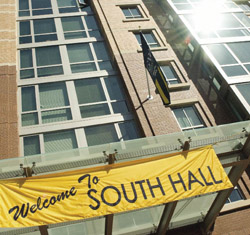
South Hall features green building elements such as low-VOC paints and bamboo paneling.
Jessica McConnell
GW has been greening its campus with everything from increasing university wide recycling rates to creating an Office of Sustainability. The biggest project yet—in sheer size—is a new 90-foot-tall, 192,000-square-foot green residence hall built to Leadership in Energy and Environmental Design (LEED) environment and energy performance standards.
At 2135 F Street, South Hall welcomed the first students into its eco-interior this fall. The new building, which houses mostly seniors, is part of a partnership project between the University and neighboring D.C. public high school School Without Walls.
Green indoor features include low volatile organic compound paints, which don’t release the noxious fumes of regular paints; bamboo paneling; recycling bins in the lobby and on each floor; greenly produced carpet tile; low-flow plumbing fixtures; Energy Star appliances; highly insulated walls; energy-efficient windows; cooler temperatures from a white roof; and more. Outside, residents enjoy ample bike storage, native plant gardens, and an open air plaza.
In addition, the dorm’s energy performance is 24.5 percent more efficient than industry standards, and during construction, more than 60 percent of the construction waste was recycled or reclaimed.
The University is aiming to achieve LEED designation—awarded by the U.S. Green Building Council—at the gold level in early 2010.
“We want to demonstrate our leadership in energy and environmental design by targeting certification for all new buildings,” says Nancy Giammatteo, director of facilities planning and environmental management. “As part of President Steven Knapp’s commitment to reducing our carbon footprint, South Hall’s LEED certification is another step in the right direction.”
In the lobby, the bamboo wall paneling fosters a soft, calming atmosphere. Counters under two announcement boards have convenient slots for depositing paper, cans, and plastic bottles for recycling. Outside, native landscaping creates a natural ambience for city gardens, which are filled with neatly arranged cone flower, nandina, astilbe, coreopsis, and nearly 600 daffodils. The center courtyard, which has tables as well as greenery, provides a quiet respite from the bustling city.
The high-efficiency building sleeps 474 students in apartment-style suites typically composed of four single bedrooms and two private bathrooms. Spacious and modern, each suite has a washer and dryer in the unit, a common living room, a dining area, and an eat-in kitchen.
Students will also receive Brita water filters for each room, thanks to a $10,000 grant secured by a graduate student to encourage use of reusable bottles.
The new building, which took nearly two years to construct, brings a new residential opportunity to campus, increasing the number of seniors who want to remain on campus.
—Carrie Madren
School of Engineering Celebrates 125 Years
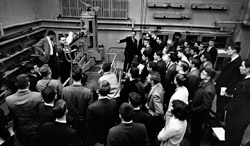
In 1962, engineering students watch concrete under stress in a powerful press in the Materials Testing Laboratory.
University Archives
GW’s School of Engineering and Applied Science celebrates its 125th anniversary this year with special events, capped by a 125th anniversary gala and a distinguished lecture series. The festivities—bringing together SEAS students, alumni, faculty, and friends—combine a nostalgic look back with a strong focus on the future.
“SEAS has undergone many transformations in its lifetime, and this milestone anniversary is a perfect time to reflect on our past and position ourselves for the years ahead,” says Dean David S. Dolling, who took over the reins of the school last year. “We have a strong school and a tremendous launching pad from which to go forward.”
SEAS opened its doors on Oct. 1, 1884, as the first school of science and engineering in the District of Columbia. Originally known as the Corcoran Scientific School, the institution was established by retired Washington banker and philanthropist William Wilson Corcoran, who had long championed the need for a scientific college in the nation’s capital. Created as a night school, SEAS was initially housed in a four-story building owned by Columbian University (the precursor to GW) on the southeast corner of 15th and H streets. In its early days, the school focused on a limited range of engineering disciplines, granting degrees in civil, mechanical, and mining engineering.
The school grew rapidly in scope following its 1905 transformation into the Washington College of Engineering and continued its development into a modern engineering college after its 1912 move to Foggy Bottom. In 1928, the college was renamed the George Washington University School of Engineering. With the onset of World War II, the engineering school assumed an important role in educating young military officers and became a leader in rocket and ordnance research. Faculty members developed the recoilless anti-tank rifle (the bazooka), as well as a variety of short-range mortars and elements of small rockets.
In 1956, the school secured a building of its own—Tompkins Hall, on 23rd Street, equipped with modern mechanical, civil, and electrical engineering laboratories, and in 1962, it acquired its current name—The School of Engineering and Applied Science. Today, SEAS is home to top-notch undergraduate and graduate programs in biomedical engineering, civil and environmental engineering, computer science, electrical and computer engineering, engineering management and systems engineering, and mechanical and aerospace engineering, as well as several renowned research centers.
Now SEAS is poised to begin the next chapter as planning begins for a world-class, 500,000-square-foot science and engineering complex on the Foggy Bottom Campus.
Targeted SEAS growth areas include nanotechnology, biomimetics and bio-inspired engineering, high-performance computing, transportation safety, computer security and information assurance, and crisis, risk, and knowledge management.
“It’s an exciting time for SEAS as we prepare to take the next leap forward,” Dr. Dolling says. “We encourage all of our stakeholders to join us and ‘be a part of it.’”
—Jamie L. Freedman
A Prestigious Pep Talk
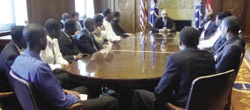
U.S. Attorney General Eric Holder talks with the GW men’s basketball team as part of its mentoring program.
Dan Greene
U.S. Attorney General Eric Holder used a page from his personal playbook to encourage GW men’s basketball team members to prepare for success. The nation’s first African-American leading law officer told the student-athletes during a visit at the U.S. Department of Justice that dedication and discipline are essential, both on and off the court.
“Especially for young people, he gives us hope, he gives us this sign that we can do whatever we want if we focus,” says point guard Travis King, a redshirt junior on the team. The players got a chance to chat with Mr. Holder on Sept. 21 as part of the team’s mentoring program, which partners with successful professionals in the Washington, D.C., community. Leroy Charles, assistant vice president for development and government relations at GW Medical Center, is a personal friend of Mr. Holder and set up the visit.
The players toured the Department of Justice building before shaking hands and snapping photos with Mr. Holder, who received an honorary Doctor of Laws degree from GW in 1998. Coach Karl Hobbs says the meeting was a chance for a remarkable role model to emphasize education.
“At some point, the air goes out of the basketball,” Coach Hobbs says. “And we want these players to understand that there are opportunities outside of sports where they can contribute to society.”
—Jaime Ciavarra
Journalist Frank Sesno Named SMPA Director
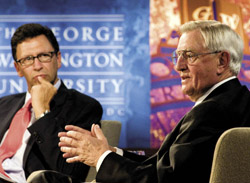
Frank Sesno, professor and director of the School of Media and Public Affairs, spoke with former U.S. Vice President Walter Mondale to kick off the 2009-10 Public Affairs Project Conversation Series.
Jessica McConnell
Emmy Award-winning journalist Frank Sesno was named the new director of GW’s School of Media and Public Affairs and is heading a special conversation series that has drawn major political players to GW.
SMPA, which is part of GW’s Columbian College of Arts and Sciences, combines liberal arts education with professional training, promoting a combination of theory and practice through its master’s and two undergraduate degree programs. Professor Sesno assumed his new position in September and succeeds Lee Huebner, who returns to GW’s faculty.
Professor Sesno is leading the school at a time “when students must be prepared to excel in the rapidly changing news and media environment,” he says. “These new changes are reshaping the practice of journalism, the way we communicate, and the way governments and citizens use media to connect.”
Professor Sesno’s career in journalism spans more than three decades and includes 21 years at CNN, where he served as White House correspondent, anchor, and Washington bureau chief. At GW, he is director of GW’s Public Affairs Project, which organizes events that focus on media, public policy, and culture.
Professor Sesno moderates the project’s conversation series that brings together influential personalities in government, mass media, and the business world. On Sept. 23, the current season began with former U.S. Vice President Walter Mondale in a discussion of his life in politics, the barriers he faced and broke, his victories and losses, and the direction of the Obama-Biden White House. On Oct. 5, Professor Sesno and CNN Chief International Correspondent Christiane Amanpour spoke with U.S. Secretary of State Hillary Rodham Clinton and U.S. Secretary of Defense Robert Gates about the reach and limitations of American power. Past guests also included George Stephanopoulos, Ted Turner, Gwen Ifill, and five former U.S. secretaries of state.
Professor Sesno has won several prestigious journalistic awards, including an Emmy, several cable ACE awards, and an Overseas Press Club Award. He is a member of the Council on Foreign Relations and has a Bachelor of Science degree from Middlebury College.
New Nursing Degree Nurtures Graduates
Does your profession need a Plan B? Career changers now have an easier time jumping into the medical field with a Bachelor of Science in Nursing degree offered at GW’s Virginia Science and Technology Campus.
The new 15-month program, which started this fall, is designed as a second bachelor degree program and was developed to meet the increasing demand for nurses in the region and across the nation. The U.S. nursing shortage is projected to grow to 260,000 registered nurses by 2025, which would be twice as large as any nursing shortage experienced in the country since the mid-1960s, according to a 2009 American Association of Colleges of Nursing study.
GW first offered a nursing program in 2004, starting with a master’s of nursing; in 2007, the school added a doctorate program.
“What we were missing and what community hospitals have asked for is an entry-level nurse program, particularly out in Virginia,” explains Jean Johnson, senior associate dean for health sciences.
The School of Medicine and Health Sciences designed the full-time program for students who already have a bachelor’s degree in another field and wish to pursue professional nursing as a career. This fall, 20 students started the program. Next year, the number of students will double, and the following year, increase to 70 students.
Second bachelor of nursing degrees are quickly growing around the country, says Ellen Dawson, chair of the Department of Nursing Education. Currently there are 205 accelerated second-degree BSN programs in the United States, with others in the planning stages, according to the American Association of Colleges of Nursing.
“The accelerated second-degree program students are typically mature, motivated, have previous work experience, and are eager to learn,” Dr. Dawson says.
In addition to coursework, nursing students learn skills and technology in a new Nursing Simulation Learning Center on the campus. In the lab, nursing students learn how to take vital signs and assess medical situations with state-of-the-art mannequins.
“A lot of the program is clinical decision making,” Dr. Johnson explains.
With a generalist degree, graduates will be able to work in any hospital clinic, nursing home, or public health center after passing a national exam.
In addition, students will be in class with graduate nursing students, gain perspective in the discussions from experienced nurses, attend an on-campus three day summer leadership institute with graduate nursing students, and may receive 12 credits from their BSN program as advanced standing in the MSN program, Dr. Dawson says.
Those 12 graduate credits can be applied to any GW Master of Science in Nursing degree within five years of completing the bachelor’s, if the student wants to specialize.
—Carrie Madren
Worldwide Perspective
GW’s first Global Forum examines U.S.-Asia relations
GW’s inaugural Global Forum in Hong Kong on Nov. 13 and 14 will provide an opportunity for members of the University’s worldwide community to share ideas about the most pressing issues facing the United States and Asia today.
During this time of international change and policy challenges, the forum aims to bring together leading GW faculty members, acclaimed alumni, and noted experts to exchange insights on political, economic, business, security, and foreign policy matters.
Speakers and panelists include GW President Steven Knapp; Ambassador Susan C. Schwab, PhD ’93, an American educator and former U.S. trade representative; GW Professor David Shambaugh, director of the China Policy Program at the Elliott School of International Affairs; and other faculty members, alumni, and U.S. and Asia experts.
Frank Wong, BA ’79, president of the GW alumni chapter in Hong Kong, says alumni in his area are proud that the first-ever forum will be held in one of Asia’s most exciting locations.
“This forum will showcase GW’s intellectual firepower to leaders in Asia and strengthen our growing alumni network,” Wong says. “It’s time that we raise GW’s international profile to match our academic excellence, and the Global Forum is a big step in that direction.”
The GW Global Forum comes at a time when the eyes of the world will be on Asia. The Asia-Pacific Economic Cooperation CEO Summit, held Nov. 12 to 14, will draw world leaders to Singapore, including U.S. President Barack Obama.
For updates about GW’s inaugural Global Forum, check out alumni.gwu.edu/programs/intl/globalforum/.
The Global Forum is sponsored by FedEx Express Asia. The broadcast media partner is Bloomberg Television and the print media partner is Time Asia. Supporting organizations include the American Chamber of Commerce in Hong Kong and the Asia Society.
GW Paleontologist Discovers Bird-like Dinosaur
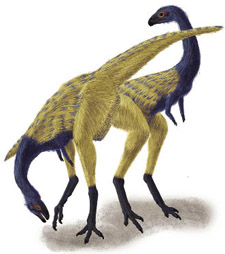
A rendering of what the dinosaur species Limusaurus inextricabilis may have looked like.
Portia Sloan
During the Jurassic Age, a half-dozen beaked, plant-eating dinosaurs perished in pools of mucky mire in what is now the Gobi Desert of northwestern China. Some 160 million years later, a team of 20 paleontologists and researchers has uncovered the skeletons to reveal a new species and expose a valuable piece of an evolutionary puzzle that has perplexed scientists for decades.
The discovery of Limusaurus inextricabilis (meaning “mire lizard who could not escape”) demonstrates that theropod, or bird-footed, dinosaurs were more ecologically diverse in the Jurassic period than previously thought, and it offers new evidence about how the three-fingered hand of birds evolved from dinosaurs. The discovery was published in the journal Nature in June.
“We knew it was something totally different,” explains James Clark, the Ronald B. Weintraub Professor of Biology in the GW Columbian College of Arts and Sciences, when the team uncovered the first skeleton. Limusaurus is in a group of theropod dinosaurs typically from the Southern Hemisphere called ceratosaurs. “This was the first ceratosaur found in Asia,” Dr. Clark says.
A close examination of the fossil shows that its upper and lower jaws were toothless, revealing that the dinosaur had a fully developed beak. Its lack of teeth, short arms without sharp claws, and gizzard stones (which aid in digestion) suggest that it was a plant-eater, though it is related to carnivorous dinosaurs.
An unusual hand structure of the new species also provided an important clue to the evolution of birds’ hands, Dr. Clark says. On modern birds, it appears that the fingers fused in the wingtip are the middle three, and the outer and inner finger were lost. But on dinosaurs, scientists believed they lost the outer two fingers, leaving the three inner fingers. If, as paleontologists surmise, birds evolved from one group of dinosaurs—the theropods—then why don’t their fingers match?
Dr. Clark and his team found that Limusaurus inextricabilis, however, had a tiny first finger and was perched at a critical point in the evolutionary tree of theropods, when five fingers were reduced to four. Close study of theropod fingers suggests that their first finger was lost and their fourth finger enlarged.
“I’m sure in the popular culture nobody cares about this, but scientists think this is weird and argue a lot about it,” says Dr. Clark, who was co-leader of a team of 20 researchers that included GW professor Catherine Forster and GW graduate student Jonah Choiniere.
Dr. Clark has spent the past 18 years searching the Gobi Desert for dinosaurs. In 1991, he helped organize the first American expedition to Mongolia with the American Museum of Natural History. In 2001 he began expeditions to China with Chinese dinosaur researcher Xu Xing of the Chinese Academy of Science’s Institute of Vertebrate Paleontology and Paleoanthropology in Beijing. For the past seven years, Dr. Clark’s field work with Dr. Xu has focused on dinosaurs from the middle of the Jurassic period, in the far western reaches of the Gobi.
—Carrie Madren
University Recognized as a Good Neighbor
The George Washington University was named one of the Top 25 “Best Neighbor” Colleges and Universities in a study by Westfield State College. The study, which was released in October, recognized those schools that have a positive impact on their urban communities and help form a shared vision with community members.
The study highlighted several of GW’s organizations and community relations initiatives, including GW’s Center for Excellence in Public Leadership, which trains community and civic leaders to lead, organize, and influence positive change in their communities; FRIENDS, a group that facilitates discussion and mutual understanding through open public meetings between Foggy Bottom/West End residents and the University; and GW Hospital, which provides care to thousands of D.C. residents and surveys city health trends.
The top 25 colleges and universities were selected based on written surveys, interviews with college presidents and other stakeholders, and, in some cases, in-person visits. GW ranked No. 24 and was the only school in the District of Columbia to receive the honor.
Web Site Revamped
GW unveiled the first phase of a new Web site in August with the goal of giving GW constituents a consistent and easy-to-navigate online experience. The audience-driven site is the foundation of an extensive University-wide effort to enhance and unify GW’s Web presence across the University’s many departments, schools, and programs.
“In the past, George Washington’s Web presence was made up of numerous designs, structures, and voices,” says Lorraine Voles, vice president for external relations, who spearheads the unified Web presence project. “The new site will give our constituents a more worthwhile experience across the main GW Web site by providing rich content, improved navigation, and an overall framework that provides a consistent look and feel across the site.”
The updated site features six main content areas that allow viewers to check out the multifaceted world of GW: Explore, Apply, Learn, Discover, Connect, and Give. The University also launched its flagship online publication, George Washington Today, which highlights GW news as well as photos and feature stories about faculty, students, and alumni.
The University is committed to evolving its online presence. “The Web presence is a direct reflection of the physical institution,” Ms. Voles says, “and we realize that everyone—from our prospective students, current students, and parents to our researchers, alumni, and friends—uses the Web to engage with us. We are committed to building a worldwide and lifelong community for GW community members, and this is a key venue for us to achieve that goal.”
The August launch was stage one of a multiyear endeavor aimed at building a unified Web presence across GW. “In the coming months, we will focus on deepening the site to include schools, departments, and programs,” Ms. Voles says. “This is an exciting first step in a forward-looking project that can enhance all of the compelling initiatives occurring at George Washington. We want the world to know the great work that is happening here every day.”
GW a Top Tweeter
Give us 140 characters, and we’ll give you the scoop.
GW is the most active university on the online microblog Twitter, with staff members posting an average of 58 tweets per day on the University’s 17 accounts, according to a study released in September by Universitiesandcolleges.org, a higher-education Web site that tracks technology trends.
That’s the most tweets—or posted messages—per day of any other university listed on U.S. News & World Report’s top 100 schools, the study shows.
Twitter and GW’s other online networks have become valuable communication tools. At any time, University staff members can update their 7,192 Twitter followers—including students, parents, alumni, and friends—about everything from free flu shots, to upcoming events, to Foggy Bottom Metro closings in postings of 140 characters or less.
Check out GW’s Twitter accounts, and learn more about the University’s online networks with Facebook, YouTube, LinkedIn, and Flickr, at
www.gwu.edu/connect/onlinenetworks.
Knapp Announces Innovation Initiative
The George Washington University will significantly increase its investment in learning and research under a plan announced by President Steven Knapp. The president’s innovation initiative will seek to increase the University’s investment in its priorities over the next five years by $60 million per year, the equivalent of what GW currently spends from its endowment income each year. Achieving this goal would in effect double the impact of George Washington’s endowment. Dr. Knapp outlined the plan in an op-ed in the Hatchet, GW’s student newspaper.
“We must now build our stature as a university that contributes intellectually to the solution of national and global problems. By matching the excellence of our instruction with the strength of our research, we will join the ranks of truly world-class universities and fully ensure the value of a GW degree. In so doing, we will also strengthen our instruction itself,” Dr. Knapp wrote in the op-ed. “Our priorities, then, are clear. We must continue investing in student learning and experience, on campus and off; and we must increase our investment in the kind of discovery that will firmly establish our international stature. In short, we must increase what we invest in our students, our faculty, and the infrastructure that supports them both.”
Dr. Knapp’s plan has three components: raising new funds from philanthropic sources; increasing the productivity of George Washington’s research and instructional programs; and finding savings in GW’s business processes that can be reinvested in GW’s faculty, students, and academic initiatives.
Dr. Knapp emphasized that the first of those efforts is “well underway,” thanks to an increase in GW’s development staff and active engagement of the University’s deans. To implement the other two parts of the plan, Dr. Knapp announced that he has launched an Innovation Task Force.
The task force will be led by a steering committee, chaired by Associate Vice President for Academic Affairs Jeffrey Lenn, and two working groups: one focusing on business processes and the other on academic innovation. The business processes committee will be led by co-chairs Dave Lawlor, senior associate vice president for finance, and Kathy Newcomer, professor of public policy and public administration and director of the Trachtenberg School
of Public Policy and Public Administration. The academic innovation committee will be led by co-chairs Dianne Martin, associate vice president for graduate studies, and Dave Steinour, chief information officer. Both working groups will include faculty and staff members from across
the University to ensure a diversity of
experience and viewpoints as well as student representation.
Input will be sought from the entire GW community through town hall-style meetings and other forums and through an electronic suggestion box: innovation@gwu.edu. The goal of the initiative is to identify deliverables by the end of
this academic year for recommended implementation.
To read the full text of Dr. Knapp’s op-ed, visit www.gwu.edu/explore/gwtoday/learningresearch.
George Welcomes…
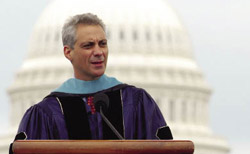
Honorary degree recipient Rahm Emanuel, White House chief of staff, was the keynote speaker at the University’s 2009 Commencement on the National Mall May 17. Emanuel offered optimism and inspiration to graduates facing a difficult job market and possibilities of the unknown. “For all of the challenges of the moment we’re in, there is a silver lining to graduating at this moment in time, because you not only have the great responsibility to serve your country, you have an extraordinary opportunity to change it,” he said.
Jessica McConnell
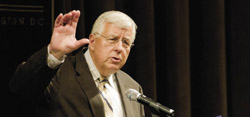
Wyoming Sen. Mike Enzi, BBA ’66, gave students career advice during a Sept. 29 event coordinated by the Alpha Kappa Psi Business Fraternity and the GW College Republicans.
Jessica McConnell
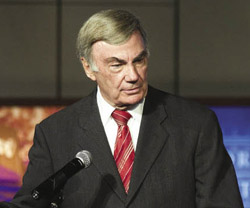
Alumni Weekend wrapped up Oct. 4 with a “Sunday Conversation” with ABC News’ Sam Donaldson.
Dave Scavone
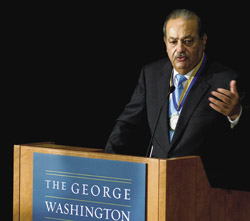
Business leader and humanitarian Carlos Slim received GW’s President’s Medal on June 30 in recognition of his significant contributions to business and community development in Mexico and Latin America and his extensive philanthropic work.
William Atkins
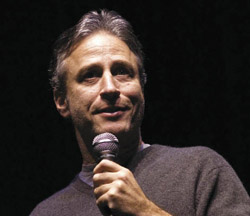
Jon Stewart, comedian and host of The Daily Show, headlined Colonials Weekend with two shows Oct. 17 that poked fun at politics.
William Atkins
|
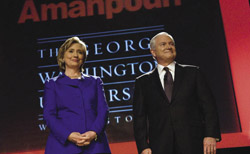
Secretary of State Hillary Clinton and Secretary of Defense Robert Gates discussed defense and diplomacy during a sold-out roundtable moderated by GW School of Media and Public Affairs Director Frank Sesno and CNN Chief International Correspondent Christiane Amanpour Oct. 5 at Lisner Auditorium.
Jessica McConnell
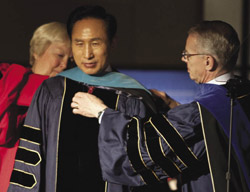
Lee Myung-Bak, president of the Republic of Korea, was presented with an honorary Doctor of Public Service degree on June 17 during a ceremony at Jack Morton Auditorium.
William Atkins
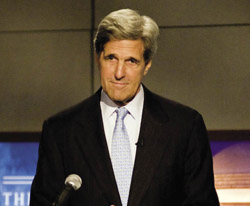
Massachusetts Sen. John Kerry was the keynote speaker at a conference discussing the connection between climate change and national security at the Elliott School of International Affairs Sept. 10.
William Atkins
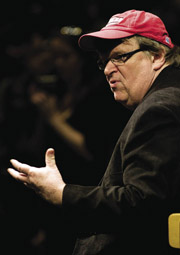
Academy Award-winning filmmaker Michael Moore urged students to remain politically active during a town hall-style discussion in the Marvin Center’s Dorothy Betts Theatre. The sold-out event was sponsored by the GW College Democrats and Program Board.
William Atkins
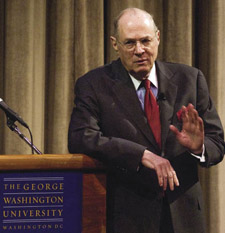
U.S. Supreme Court Justice Anthony Kennedy was the keynote speaker at a GW Law Review symposium Oct. 15.
Jessica McConnell
|









